
Overview of leading project management philosophies and methodologies
Whether it’s developing a service, designing a product, or creating a commercial strategy, managing your business projects like these most appropriately is essential. Deploying the right project management solution will provide reliable foundations for the project, leading to faster progress and better final outcomes.
Several philosophies and methodologies can be implemented to manage the project. Here’s everything your project management office (PMO) needs to know ahead of starting its next major assignment. When analysing potential frameworks, the PMO is likely to encounter three main competing project management philosophies: Waterfall, Agile and Lean.
Waterfall
Waterfall project management philosophy is one that started in the manufacturing industries many decades ago and has since been extended to a variety of industries, including services, software development, etc.
Waterfall philosophies focus on linear sequences, following a set of pre-defined stages in a chronological order to ensure that the key processes within the project are completed. The clarity of the strategy means that management becomes particularly easy, even when the project requires collaborations from teams spread across multiple locations. The eight phases of waterfall philosophies are:
- Conception
- Initiation
- Analysis
- Design
- Construction
- Testing
- Implementation
- Maintenance
Through using the straight journey set out by the eight stages, projects are taken from their beginning to logical conclusions without overlooking any of the crucial factors. This approach has clear starting points, clear aims, and clear pathways to follow. Essentially, then, it is an ideal way to complete simple projects that will not be altered further down the line.
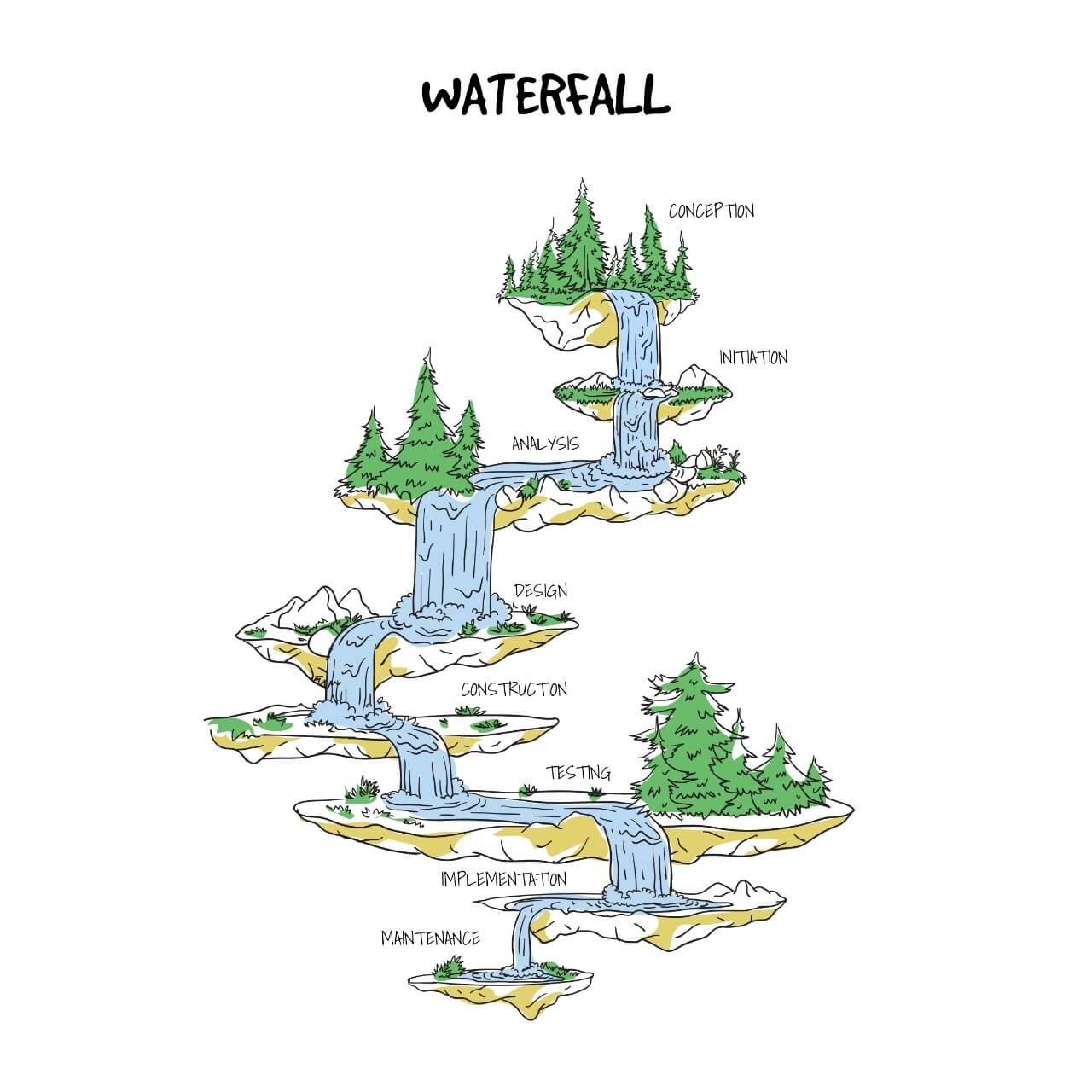
Waterfall philosophies are best used when the goals are guaranteed to offer consistency. This is because it is difficult (sometimes impossible) to go back to a previously completed stage without encountering major delays and increased expense.
Due to the changing way of the world, the number of projects using this method is on the decline. Under the right circumstances, though, it can still be very useful.
The Pros
- The use of the eight phases ensures that the project is carefully prepared before any serious design or implementation is used, which can prevent costly errors or ideas that are destined to fail.
- Clearly defined steps and goals ensure that the project is completed in a practical manner, also allowing multiple teams to work on the project simultaneously.
- Transparency throughout the project gives everyone, including the end client, great insight and accurate forecasts on costs, timeframes, and sizes.
- The status of a project can be tracked at any stage, while issues like staff turnover will not impact the project either.
- Project management through the Waterfall philosophy is built with long-term elements in mind rather than focusing solely on the immediate task at hand.
The Cons
- The product is tested only at the end, making it difficult to identify faults caused by mistakes during the early steps of the project.
- If the initial requirements are wrong, it’ll result in serious problems throughout the duration of the project ahead.
- If changes are required due to evolving requirements or business landscapes, going backward is almost impossible to do without major hiccups.
- Stakeholders and other key personnel can not see any real progress until the project has reached its latter stages.
Agile
Established in the early parts of the 21st century, Agile was conceived in the software development arena primarily as a response to the poor yields offered by the waterfall project management philosophy. As the name suggests, it brings a more flexible and malleable approach to the table.
Agile’s function as a solution to the problems and shortcomings of the waterfall philosophy manifests in the use of a simple project design that is broken into smaller modules. However, the concept follows an approach that uses regular pitstops to analyse and alter the project.
As such, it follows the simple strategy:
- Work (relating to the smaller modules) is completed in ‘sprints’. The sprints may last a week or a month.
- Once the sprint has been completed, evaluation and testing phases are used to identify faults, gain feedback, and make any necessary changes.
- The next sprint is completed to see further progress on the modules before the testing phase is repeated.
The cycle is a simple one but focuses on the ideology of ensuring that the project keeps moving in the right direction at all times. Crucially, the philosophy is designed to create a working product at each iteration. Even when an early incarnation falls a long way short of where the final product will end up, each stage forms an important step on the road to success.
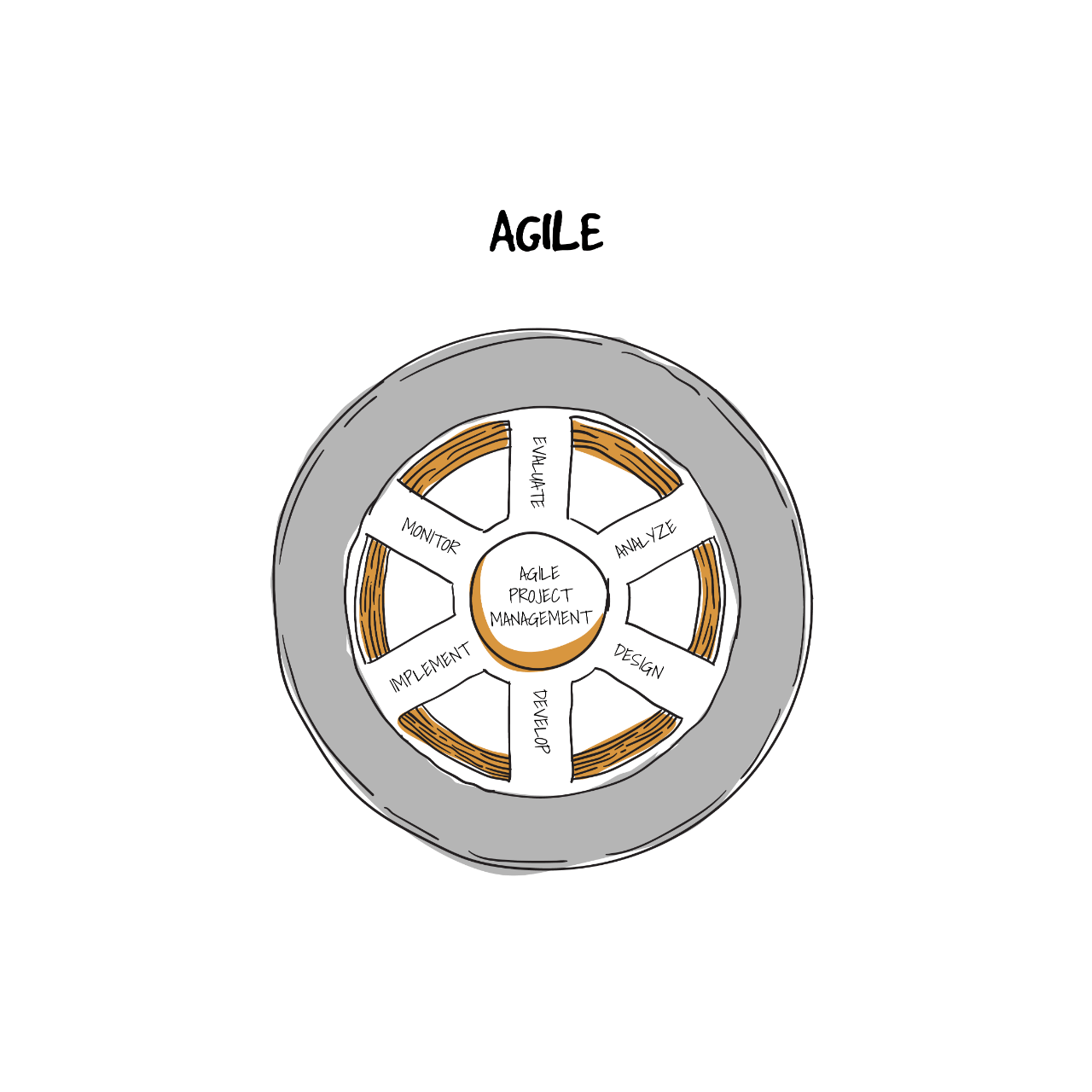
As it is a particularly versatile strategy, the agile philosophy is best used when the final goals are not set in stone and may morph as the project develops. Given that each sprint takes time, it might not be the right solution when projects need to be completed to their final version in a short space of time.
Still, when there is flexibility on the timescales, the continued testing and analysis will enable the project to be completed to the highest standard while retaining relevance even if outside changes impact the requirements of the project.
The Pros
- The flexible approach allows for the project to evolve in a logical and practical manner to produce stunning outcomes.
- Each sprint gives a set deadline, ensuring that work needs to be progressed to complete the next phase of the journey.
- Faults and bugs can easily be identified and will become the main focus of the next sprint cycle until it is fixed.
- It is far easier to ensure that the development cycle keeps up with the latest advancements in technologies and expectations.
- The ability to show shareholders the project at each phase allows for easier guidance and keeps the project on the right track.
The Cons
- The lack of clear timelines can lead to a long delay in the proposed completion date and the reality of the situation.
- The malleable plan can easily become distorted, resulting in a vastly different end product to the one that was initially proposed.
- Perfectionists may never be happy with the outcomes, meaning that time and money will be wasted without ever reaching a solution.
- Different people can have contrasting ideas, which can lead to complications as there are not defined pathways.
Lean
As the name suggests, Lean philosophies aim to take a streamlined approach to project management. The goal is to accelerate the progress of the project, enabling results to be achieved on time and budget with huge success ratios.
The lean processes aim to deliver the Minimal Viable Product (MVP) to clients and stakeholders very quickly. Crucially, the product also hits the marketplace far sooner. Naturally, then, this is a great way to manage short and sharp projects that have clear goals and are considered relatively simple.
While lean philosophies strip back the project to its essential bare bones, the exact strategies used can be influenced by a host of different elements. The approach is primarily concerned with the immediate requirements rather than future elements. Nonetheless, the quick turnaround times allow for quicker identification of faults and unworkable ideas. This can include trashing entire projects under the right circumstances.
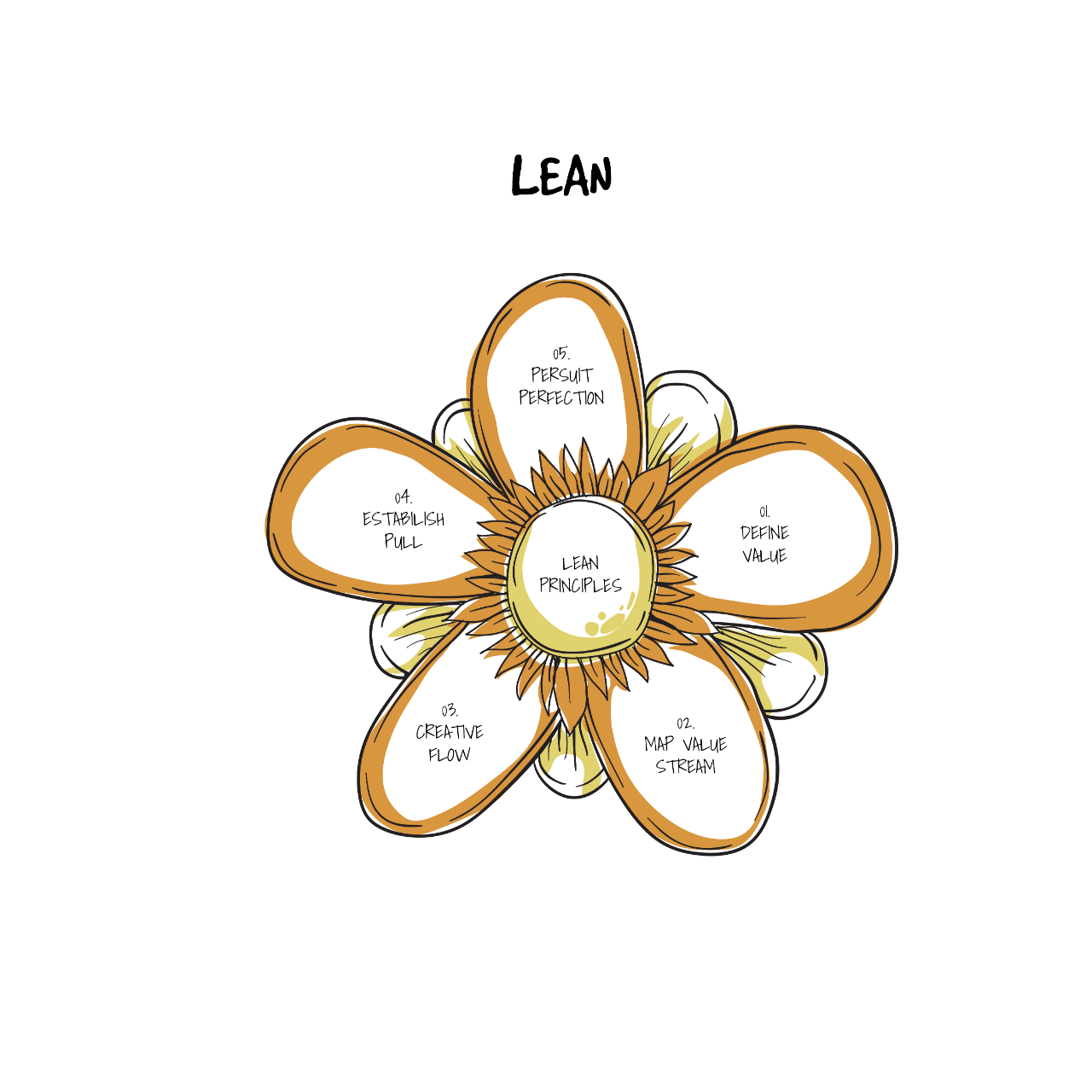
The narrow focus also aims to produce the exact user requirement without deviating from the core purpose or function of the project. The PMO can use the lean approach for assignments that do not require much afterthought, although this philosophy doesn’t necessarily need to put a definitive end to the project – it is still possible to reopen the project after completion for modifications and upgrades. Nonetheless, the waterfall and agile philosophies are probably better suited.
Lean philosophies are about speed and efficiency when over analysis could potentially disrupt the process. Real-time project statuses can still be used while there are clear priorities across the enterprise too.
The Pros
- It’s a quicker and often easier approach that will generate savings of your two most significant resources – time and money.
- It’s very easy to identify problems or even spot when a project is destined to fail, leading to reduced waste.
- It allows you to get products out on the marketplace far sooner, enabling quick ROIs and the ability to move onto the next project.
- It avoids the threat of dwelling on perceived issues that actually have no influence on the project or company.
- It encourages the implementation of winning strategies for future projects, which can be hugely rewarding for the PMO.
The Cons
- Lean processes can lead to limited end results as restricted analysis can impact the opportunities to make the necessary changes.
- Lean methods require all members of the team to collaborate in a seamless fashion or else the damage can be enormous.
- Lean philosophies are prone to seeing projects being rushed. When issues arise, they may be prematurely abandoned.
- Lean strategies are often focused solely on the short-term requirements rather than the long-term needs of the project, product, or business.
There is no single right solution to which philosophy should be used, and they all have their positives and negatives in a range of situations. While most businesses will find that they have a clear preference for their specific strategies, it may be possible to use the others at varying stages.
In addition to choosing the right project management philosophy, it’s essential for PMO teams should take great care in finding the right methodology for their projects or projects. While there are many potential avenues to consider, there are five main project management methodologies: Scrum, Kanban, Kaizen, Six Sigma and Crystal.
Scrum
Scrum is a methodology that falls under the Agile philosophy and is primarily associated with software development, although it is becoming increasingly common in other working areas. The methodology is a reaction to the traditional approach of the sequential waterfall philosophy and encourages teams to work on a common goal using a holistic and malleable approach that can evolve alongside the needs of the project.
The term is not an acronym, despite often being inaccurately capitalized. The method works on the idea that the ‘scrum master’ manages a team in which each member has a set role. The goals defined by the product owner will be executed by the team, who will follow the sprint and testing cycles of the agile philosophy.
While works completed from each sprint will need to meet the predefined deadlines in order to be ready for the reviews, the deadline of the final deliverance is very flexible. The Scrum process discourages changes during sprints, preferring to focus on the analysis phases to identify the changes that will be required during the next cycle.
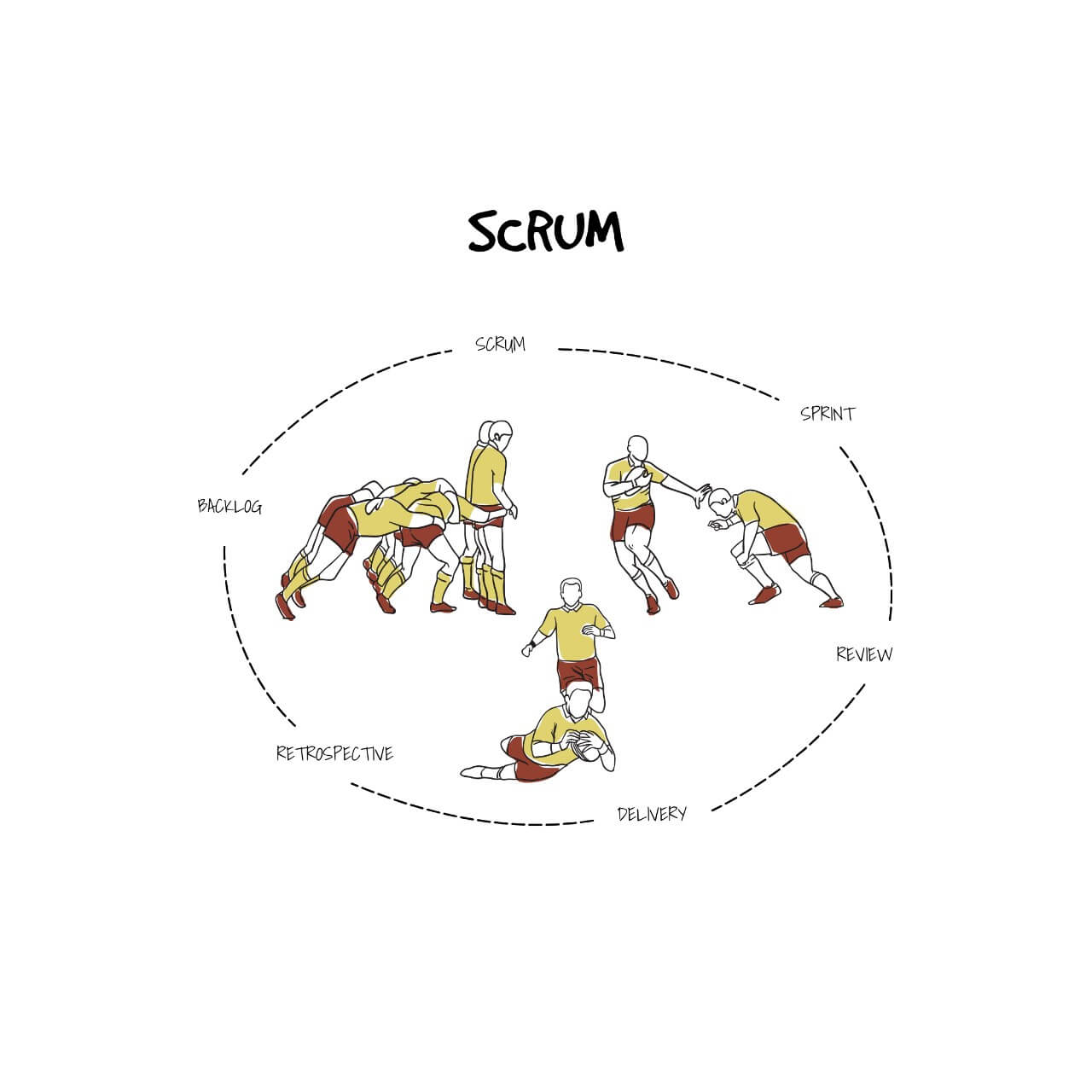
The success of each sprint is largely dependent on the success of its predecessors. For this reason, the Scrum methodology is often deployed by teams that work in a cohesive manner on pre-defined objectives that are not likely to change drastically during the course of the project. However, being an agile philosophy, there is still room for alterations if and when required.
In Scrum methodologies, it is commonplace for the team agrees on the objectives of the project plan and members will be responsible for the same tasks within each cycle and iteration. The methodology also accepts that client needs and desires often evolve during the course of the project. As such, there is a clear motive to deliver quick results and react to changing requirements, technologies, and market conditions.
The Scrum process usually includes several stages, including:
- Sprint Planning Meeting – the pre-sprint discussions will set out the ideas and define the work that needs to be done. This will include prioritising the workload and deciding how much work can be completed by individual members during the sprint cycle.
- Daily Scrum – a daily meeting is used to discuss what was worked on during the last 24 hours while also plotting the current day’s workload. In most cases, the daily scrum is limited to a duration of no more than 15 minutes.
- Sprint Review – following the completion of the sprint, a feedback meeting is arranged and used to showcase any functional additions and achievements that have been accomplished during the sprint. Product owners may ask stakeholders for feedback too.
- Sprint Retrospective – the retrospective team meeting is used to reflect on the success and failings of the recently completed sprint phase while also pinpointing the critical areas of improvement in the subsequent sprint.
Spreadsheets, task boards, and project management software may be used to promote smooth transitions.
Kanban
The Kanban methodology is one of the most versatile project management methods on the market, which is why it’s also one of the most popular and is used by teams of all shapes and sizes to achieve a range of goals.
Etymologically speaking, the term originates from Toyota’s “just-in-time” production system. It aims to remove wasted time and requirements to encourage greater efficiency across the project. In turn, this aims to streamline the process for quicker progress while also placing a huge emphasis on transparency. To do this, Kanban utilises a lot of visual elements.
Kanban methods focus on time efficiency and ensure that each member of the team can see who is responsible for each task. Online Kanban boards are used to connect team members and keep all aspects of organisation in one place. This shows due dates, estimated completion times, prioritised checklists, and a list of group members.
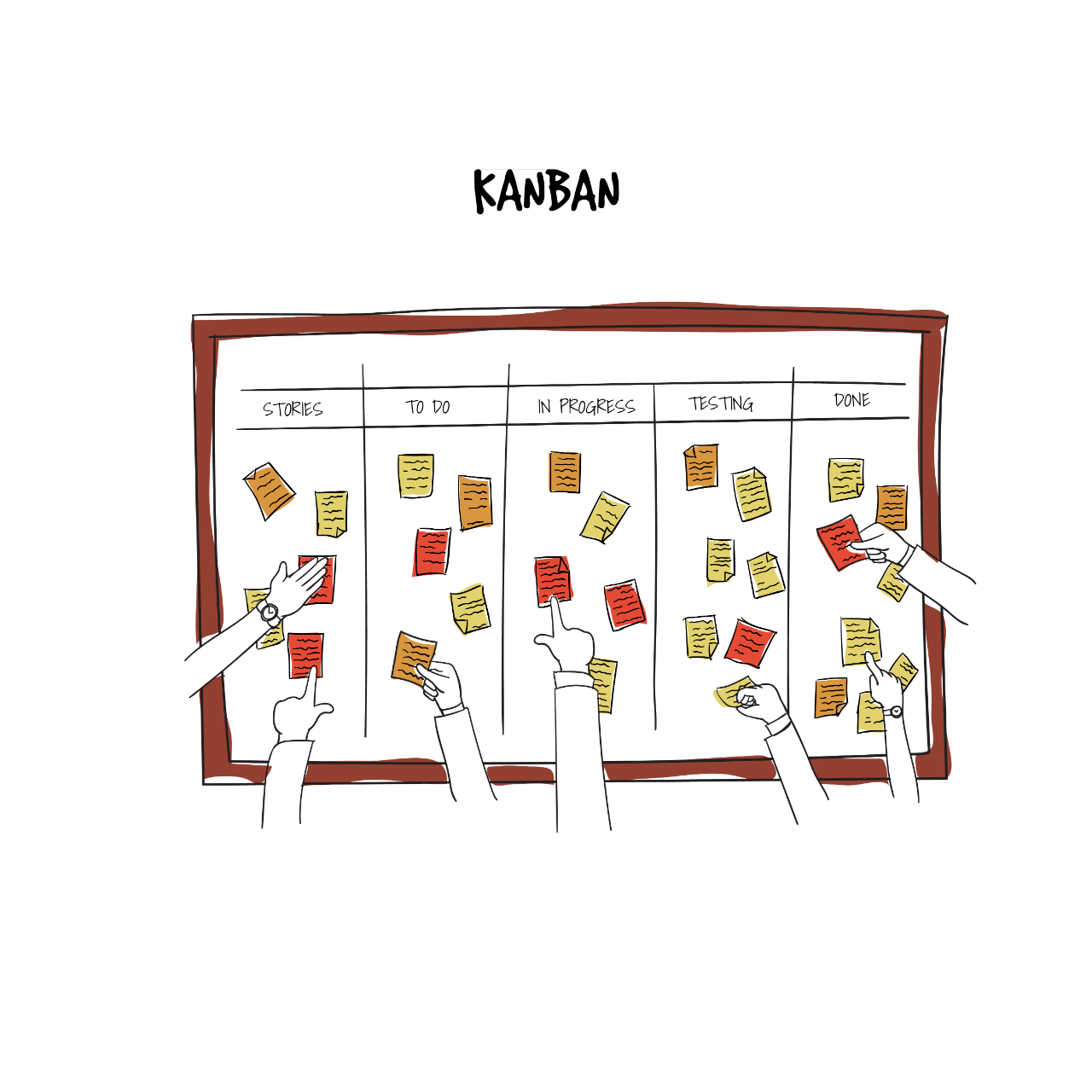
The use of a Kanban board can be very popular when using Agile philosophies, particularly during the sprint phases. Works are easily managed through the use of smaller modules while it focuses on the relevant information for efficient working. Better still, it encourages ongoing improvements.
While many project management strategies promote the idea of multitasking, Kanban believes in focusing on one actionable task at a time. In this way, then, it borrows ideas from the waterfall philosophy, which underlines the flexibility and widespread appeal. Its aim is to help teams achieve maximum workloads without losing efficiency.
The visual nature of Kanban boards is unquestionably one of the method’s biggest strengths, bringing a huge sense of clarity to the project management arena. Whether using a digital board or a handmade one (perhaps on a whiteboard using colour coded sticky notes), there is no need to overcomplicate the process.
In fact, many teams find that focusing on just three main columns is all that’s required:
- Not Done – all tasks start in this column, and can be ranked in priority so that the key assignments are taken on first.
- In Progress – tasks are moved to this column once the designated member has taken the task on.
- Done – tasks are moved to this column when done.
The above strategy works well for sprints. However, waterfall processes may wish to add additional columns such as ‘in review’. Furthermore, teams can add individual rows for each member of the team. This enables the team to quickly see who isn’t pulling their weight while colleagues can take over if a team member is stuck on a specific task.
Kanban’s visual aspects make it very easy to follow the project from its starting point through to its logical and natural conclusion. This makes it a good option for any of the three fundamental philosophies.
Kaizen
Kaizen, a term which loosely translates from Japanese to mean “change for the better” embraces a methodical approach to project management and productivity, relying heavily on the idea of gradual improvement.
The method is built upon a number of principles, including the use of a stronger team bond as well as the ideology that positive practices generate positive results. It also believes in finding the root of a problem and rectifying it in a bid to implement standardised upgrades that can guide future projects to greater efficiency and success. It also encourages team members to identify waste and eliminate it from the project entirely, thus streamlining the process. Kaizen can, therefore, be used alongside lean philosophies as well as waterfall and agile philosophies.
Kaizen embraces coordinated and continuous endeavours to bring small but steady improvements to ensure that projects (and the company) follow the right path for ongoing improvement with the idea of ensuring that tomorrow is always better than today. This manifests itself through incorporating new ideas, challenging current practices, and focusing on execution rather than excuses.
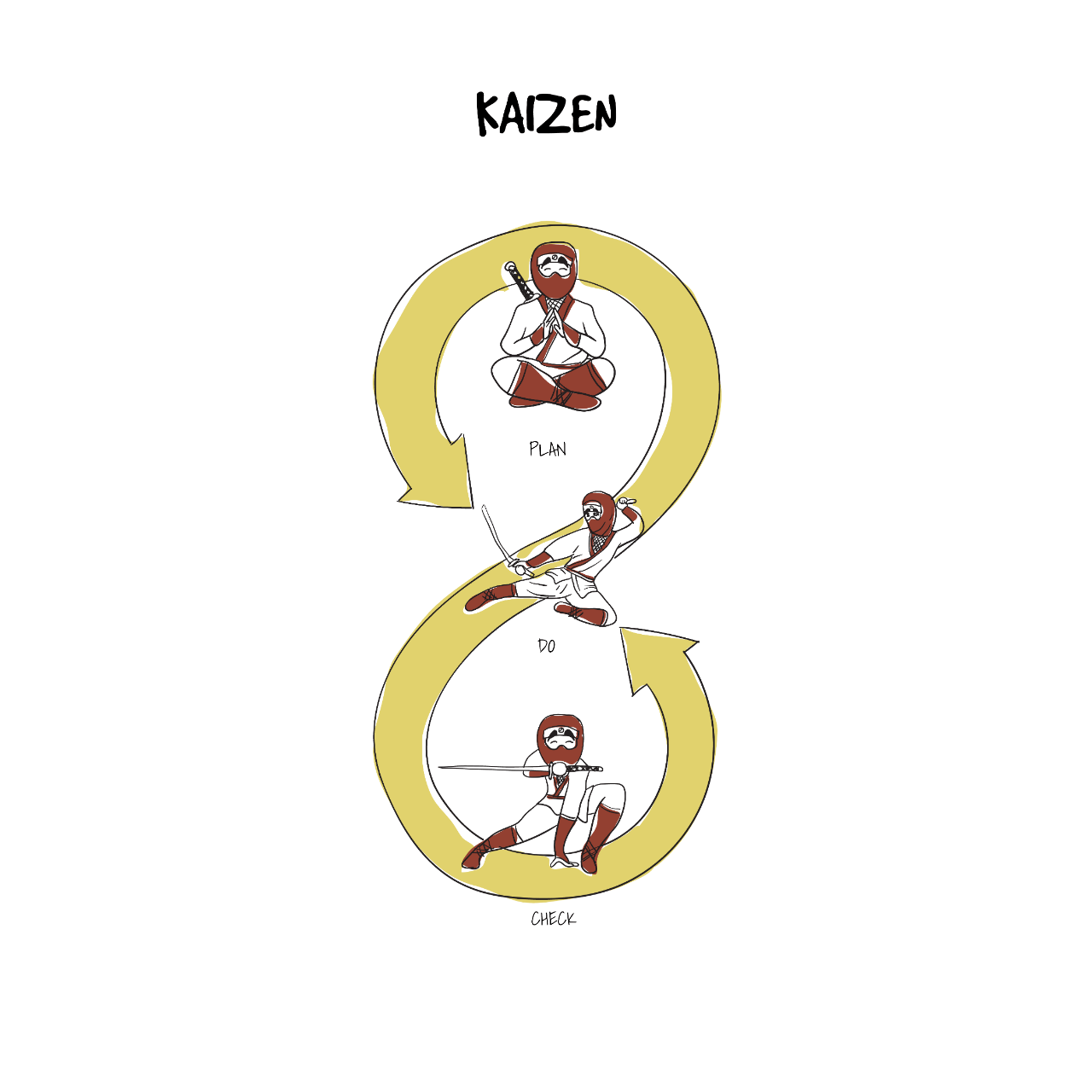
When PMOs take on the Kaizen method, it must ensure that all team members consider the present condition of their work, the desired levels they wish to reach, and the actionable steps that can be used to make it happen. In most situations, this will result in three main phases:
- Participation: Getting team members on board through promoting the benefits of Kaizen for the group as well as the individuals within it will help. Incentivising employees through financial rewards and related perks can have a telling influence too. Establishing a winning atmosphere and united mindset is a vital part of the process.
- Education: Kaizen is something that needs to be developed and tailored to suit the unique objectives of the business and the teams within it. Team leaders need to focus on organisational elements before sharing the knowledge in an engaging way to incite big responses from all members within the team. Kaizen only works when everyone is on board.
- Growth: Kaizen is a long-term method that embraces gradual improvements. As such, long-term implications and applications need to take priority. The main aim, from a project management perspective, is to ensure that all habitual and strategical changes are designed with the organisational objectives in mind.
In many ways, Kaizen is a project management method that works almost like a concept rather than a system itself. However, it is best used alongside goals and measurable objectives. When ongoing improvements are used to achieve those targets, the final products of those projects will see drastic upgrades.
Kaizen is particularly popular for businesses and PMO teams that wish to promote individual initiatives as well as harness team unity. It can fit into your philosophy to create an improved company culture and boost natural engagements from all team members on all future projects. The actionable organisational elements that target specific areas of improvement within the company add a sense of practicality that can generate rapid results.
Six Sigma
The Six Sigma methodology has existed since 1986 and focuses on the identification and subsequent removal of defects within a project. By spotting and quantifying the root causes through empirical and statistical quality management methods, the system aims to bring stability and predictability to productivity.
Six Sigma is a methodology that requires improvements from the top down within the operation, prioritising measurable metrics and characteristics that can be analysed with ease. It subsequently utilises the idea of data-driven decisions to enhance the processes.
As a framework, then, Six Sigma relies on five main steps. Its roadmap looks like this:
- Define the fault or aspect that needs correcting. This stage is used to identify goals, potential resources, and scope while also considering the timelines. It is also a time to determine the roles of team members.
- Measure to gain quantifiable results. Data will be used to contextualise the processes and the data gained from the project’s endeavours. With high-quality data, the systems used within the project will become far more efficient.
- Analyse the data to make accurate decisions regarding the current obstacles and how they can be successfully removed. Analytical tools should be used to prioritise potential root problems while also creating detailed process maps.
- Improve the project by implementing the new elements. Creating solutions devised from brainstorming will be followed by testing the easiest solutions and building an implementation plan to successfully change the path of the project.
- Control and achieve sustained results. This includes implementing any updates that may be required. Charts and visual tools will often be used to monitor situations and guide the project towards a stable solution.
The methodology can be incorporated into any of the three main philosophies but is best suited to the Agile philosophy. This is because agile frameworks encourage reflection and fine-tuning at regular intervals. The five steps of Six Sigma ensure that this happens to produce truly stunning outcomes while ensuring that all members of the team can collaborate in style.

In order to be implemented efficiently, Six Sigma requires dynamic software and tools. This is due to the data-driven decision-making strategies that are used to measure metrics against the project’s baseline. Without the necessary datasets, it becomes impossible to unlock the full potential of the method or the project’s productivity.
The objectives may change after sprint cycles or as technology, and client requirements change. Nonetheless, the fact that the data-driven strategies are focused on the set goals of any given time, the method can inspire very quick progress while also providing clarity for individual team members as well as the group as a whole.
It can be argued that Six Sigma won’t be suited to all projects, not least due to the fact it doesn’t use a holistic approach. In the right moments, though, it’s possibilities are incredible.
Crystal
The Crystal methodology is one that was developed in the early 1990s and was initially focused on object-oriented projects. It works on a set of shared patterns and techniques that are naturally embraced by successful teams. Crystal can, therefore, be defined as a group of methodologies.
Crystal appreciates the fact that every project is unique and is bound by its individual set of objectives, obstacles, and opportunities. The method aims to optimise teams by streamlining the projects and engaging team members in a bid to engage greater participation and creative thinking. A stimulated team will naturally drive the project to better conclusions.
As well as paying attention to the priorities of the project, Crystal methodologies are broken into sub-sections based on the number of people within the team (as well as the complexities this can bring). The colour-coded categories are as follows:
- Clear: defines teams of eight people or fewer.
- Yellow: defines teams of up to 20 people.
- Orange: defines teams of 20-50 members.
- Red: defines teams of 50-80 people.
- Maroon: defines teams of over 80 people.
The Crystal methodology embraces the skills and characteristics of individual team members, utilising human power and autonomy. It believes in trusting people to organise themselves and adapt to the evolving requirements and objectives. The fact that the method uses a malleable approach rather than ideas that are set in stone makes it particularly ideal for Agile philosophies. However, the fact that it doesn’t rely heavily on documentation and management also makes it suited to Lean processes.
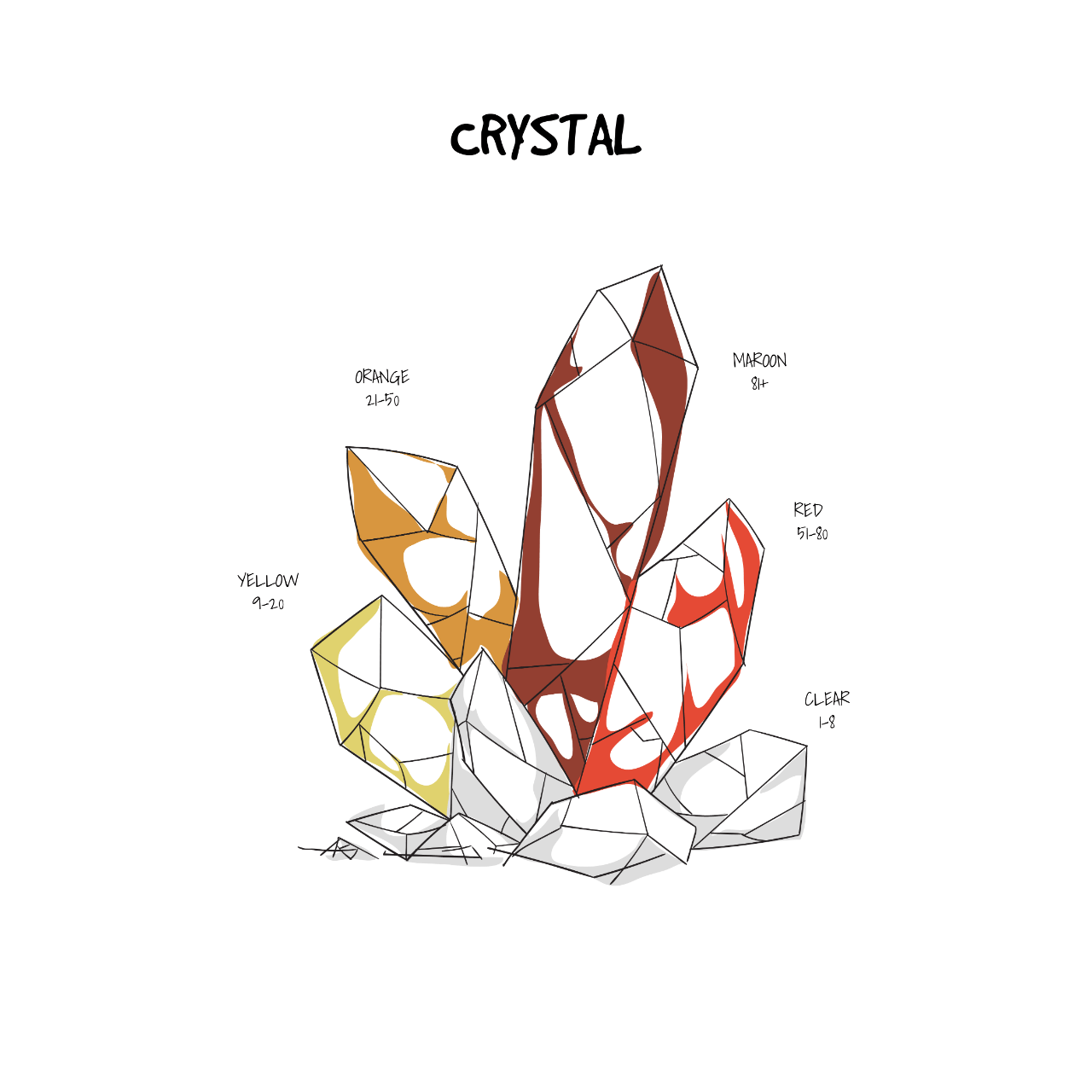
Frequent delivery is designed to prevent the threat of investing time and energy into ideas that subsequently have no future. It also uses reflective elements to identify the most important areas of improvement, regardless of whether the project is already in good condition or not. This includes spotting the opportunities offered by new technologies and techniques.
Communication and collaboration are encouraged by the method, offering easy access to all members at all times (especially when the right software is in place). This enables a strong link for regular feedback while each member of the team will have focus on their specific roles while still having a good understanding of what others are doing.
Automated testing and configuration management can also spot errors within minutes, saving time and money during the design and implementation processes. This can also rectify issues during the ongoing operations of products that are already on the market. The active methodology uses continuous integration to encourage the highest levels of responsiveness across all phases.
The flexibility of the model does not detract from the fact that this is a method is built on the idea o promoting focus on the objectives. While all members need a good knowledge of the project, the regular deliveries and analysis should point users in the right direction throughout every sprint or stage of the project.